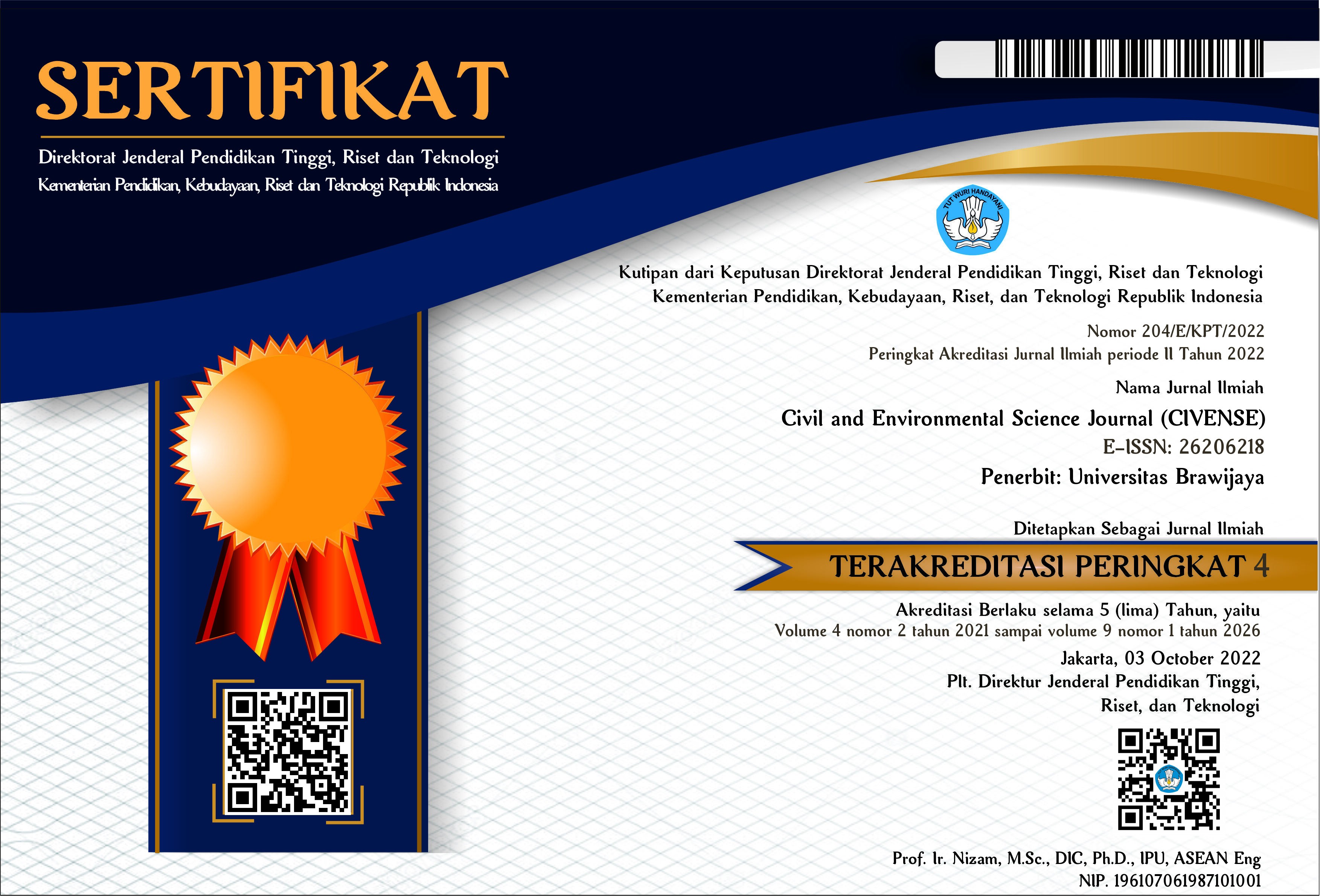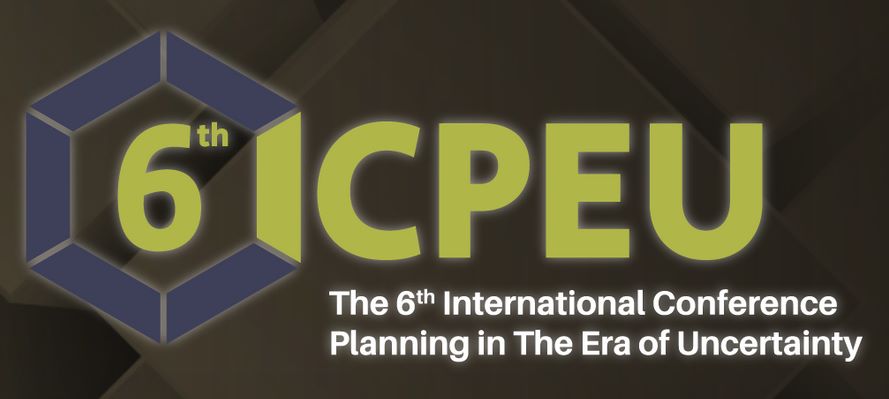Potential use of aquatic plants in constructed wetlands for simultaneous removal of Phosphate and COD from laundry wastewater
DOI:
https://doi.org/10.21776/ub.civense.2018.00102.4Keywords:
constructed wetland, COD, detergent waste, phosphateAbstract
One component of household wastewater that has a bad impact on the environment is waste that comes from washing which uses detergent, due to a fairly high phosphate and chemical oxygen demand (COD) concentration. The purpose of this study was to determine the potential of using aquatic plants to reduce phosphate and COD levels from laundry waste. This research was carried out using constructed wetlands model of laboratory scale using the combination of flow types of subsurface flow systems (SFS) and the type of vertical flow system (VFS) with a waste residence time of 5 days and 10 days. Based on the results, for model I, the average percentage of COD levels reduction is 67.62% and phosphate is 13.89%, while in model II, the average percentage of COD reduction is 59.93% and phosphate is 14.36%, after 10 days of waste residence time. Aquatic plants used in the modeling of constructed wetland can grow and reproduce well, this can be indicated by the growth of new shoots and flowers of these plants.
References
Alan W. Maki, Donald B. Porcella, Richard H. Wendt, 1984. The impact of detergent phosphorus bans on receiving water quality. Water Research, Volume 18, Issue 7, 1984, Pages 893-903.
Agustin N. M. Bagyo, Winarti Andayani, Christina Tri Suhani, 2014. Radiolysis of alkyl benzene sulfonat (ABS) in aqueous solution. Radiation Physics and Chemistry, Volume 69, Issue 4, March 2004, Pages 317-319.
Anggraheni, E. 2004. Studi Tentang Aerasi Pada Instalasi Pengolahan Air Mikro Untuk Memenuhi Kebutuhan Air Bersih Rumah Tangga. Skripsi S1. Teknik Pengairan. Universitas Brawijaya. Malang.
Kusuma, R.T., 2005. Studi Penurunan COD dan BOD5 Air Limbah Domestik dengan Menggunakan Subsurface Constructed Wetland dengan Menggunakan Tanaman Kana-Studi Kasus di Kampus Teknik Lingkungan ITS. Tugas Akhir, Jurusan Teknik Lingkungan ITS, Surabaya.
Yuanita, C. 2003. Pengaruh variasi media tanaman terhadap penurunan kandungan organic (PV) dan TSS pada pengolahan efluen IPLT Keputih, Sukolilo Surabaya dengan menggunakan tanaman cattail (Typha latifolia) menggunakan system constructed wetlands. Tugas akhir Jurusan Teknik Lingkungan ITS. Surabaya.
Riyanto Haribowo, Minami Yoshimura, Masahiko Sekine, Tsuyoshi Imai, Koichi Yamamoto, Takaya Higuchi, Ariyo Kanno., 2017. Behavior of toxicity in river basins dominated by residential areas. Contemporary Engineering Sciences 10 (7), 305-315.
H Yamashita, R Haribowo, M Sekine, N Oda, A Kanno, Y Shimono, W Shitao, T Higuchi, T Imai, K Yamamoto., 2012. Toxicity test using medaka (Oryzias latipes) early fry and concentrated sample water as an index of aquatic habitat condition. Environmental Science and Pollution Research 19 (7), 2581-2594.
Zhao Zhimiao, Song Xinshan, Wang Yuhui, Wang Daoyuan, Wang Suyan,He Yuan, Ding Yi, Wang Wei, Yan Denghua, Wang Junfeng., 2016. Effects of algal ponds on vertical flow constructed wetlands underdifferent sewage application techniques. Ecological Engineering 93 (2016) 120–128.
Jih Ming Chyan, Chien Jung Lin, Yu Chi Lin, Yi An Chou., 2016. Improving removal performance of pollutants by artificial aerationand flow rectification in free water surface constructed wetland. International Biodeterioration & Biodegradation, Volume 113, September 2016, Pages 146-154.
Huaqing Liu, Zhen Hu, Jian Zhang, Huu Hao Ngo, Wenshan Guo, Shuang Liang, Jinlin Fan,Shaoyong Lu, Haiming Wu., 2016. Optimizations on supply and distribution of dissolved oxygenin constructed wetlands: A review. Bioresource Technology, Volume 214, August 2016, Pages 797-805.
Demin Zhou, Hong Zhang, Chengliang Liu., 2016.Wetland ecohydrology and its challenges. Ecohydrology & Hydrobiology 16 (2016) 26–32.
Robert L Knight, William E Walton, George F O’Meara, William K Reisen, Roland Wass., 2003. Strategies for effective mosquito control in constructed treatment wetlands. Ecological Engineering, Volume 21, Issues 4–5, 31 December 2003, Pages 211-232.
C. Ramprasad, Chris Shirley Smith, Fayyaz A. Memon, Ligy Philip ., 2017. Removal of chemical and microbial contaminants from greywater using a novel constructed wetland: GROW. Ecological Engineering, Volume 106, Part A, September 2017, Pages 55-65.
Wilfred W. Scott., 1920. Standard Methods of Chemical Analysis. D. Van Nostrand Company.
Cooper, P., 1999. Wetland System for Water Pollution Control. Wath scie Pergamon. Germany.
R Haribowo, V Dermawan, SN Yudha., 2018. Application of Artificial Neural Network For Defining The Water Quality in The River. Civil and Environmental Science Journal 1 (01), 12-18, 2018.
Downloads
Published
How to Cite
Issue
Section
License
Copyright (c) 2018 Civil and Environmental Science Journal

This work is licensed under a Creative Commons Attribution-NonCommercial 4.0 International License.
Authors who publish with this journal agree to the following terms:
Authors retain copyright and grant the journal right of first publication with the work simultaneously licensed under a Attribution-NonCommercial 4.0 International License that allows others to share the work with an acknowledgement of the work's authorship and initial publication in this journal.
Authors are able to enter into separate, additional contractual arrangements for the non-exclusive distribution of the journal's published version of the work (e.g., post it to an institutional repository or publish it in a book), with an acknowledgement of its initial publication in this journal.
Authors are permitted and encouraged to post their work online (e.g., in institutional repositories or on their website) prior to and during the submission process, as it can lead to productive exchanges, as well as earlier and greater citation of published work (See the Effect of Open Access).














